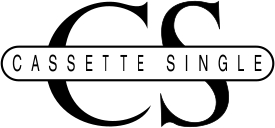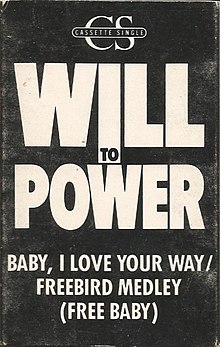Cassette single
This articleneeds additional citations forverification.(May 2011) |
 | |
 Released by theParlophonerecord label in the UK,Tina Turner's 1995 songGoldenEyeas a cassette single, listing the standard 'edit' and an extended 'club edit' on side 1. | |
| Media type | Magnetic tape |
|---|---|
| Encoding | Analogue signal |
| Capacity | Between 10–30 minutes total[1](3-6 songs/versions), sometimes repeated on both sides |
| Readmechanism | Tape head |
| Standard | Compact Cassette |
| Dimensions | 103 × 64 × 12 mm |
| Usage | Audio playback |
| Released | 1980 |
Acassette single(CS), also known by the trademarkcassingle,or capitalised as the trademarkCassette Single,is a musicsinglesupplied in the form of aCompact Cassette.The cassette single was introduced in1980.[2]
History
[edit]
The debut single "C·30 C·60 C·90 Go"fromBow Wow Wow(catalogue number TCEMI 5088) was the first cassette single released worldwide, issued byEMIin theUnited Kingdomin1980.[2]In theUnited States of America,the first cassette single was released byA&MandI.R.S. Recordsin1982withthe Go-Go's[1]"Vacation",which contained two songs available on both sides of the tape.[3]
Initially, the cassette single was supplied containing two or three versions of the primary single, sometimes also together with aB-sidesong. Typically, between 4 and 20 minutes of music were available on the early cassette singles,[3]though later offerings would be available with five or six different versions of songs.
The British independent record labelZTT Recordsmade good use of the cassette single format by1984,with singles byFrankie Goes to Hollywood,Art of NoiseandPropagandabeing issued in unique versions on compact cassette.
American record companies began releasing cassette singles on a large scale in 1987, whenvinyl recordalbumsales were declining in favour of cassette recordings; the cassette single was meant to replace the 7-inch 45-rpm record in a similar way.[1][3]
The cassette single format was used as a promotion in the 1990s, withThe Walt Disney Companygiving a "cassingle" to attendees ofHerculespromotional events.[1]
Packaging
[edit]

Originally, most cassette singles were released in a thick paper sleeve that slipped over the outside of the cassette, called anO caseor anO-card.This was then usuallyshrink wrappedin cellophane plastic. Some singles contained one song on each side, much as 7-inch 45-rpm records had done, but others repeated the songs on both sides. In some markets, cassette singles generally used the same packaging as standard cassettes, a rigid plastic box with a folded paper inlay insert (known as aJ-card).
As the cassettemaxi singleorextended play(EP) was released,[1]more intricate packaging was incorporated that looked similar to the packaging of a regularalbumcassette. These were placed in standard rigid plastic cassette cases, with a folded paper/cardstock inlay "J-card" insert. Unlike a full-length cassette album, these were generally only one two-sided inlay instead of an extended fold-out (the latter as required for song lyrics, and other additional information usually found on albums). Maxi-singles usually contained four or more versions of a single song; i.e.: typically the '7-inch single', an 'album version', a shorter 'radio edit', and occasionally a 'club edit' or 'dance mix', and a '12-inchextended version'.[1]Other options could include an 'a cappella' version, and / or an 'instrumental' version. Alternatively, some cassette singles contained differing versions of two different songs, as in a 'double A-side'.[4]
Popularity
[edit]Although thecassettehad reached a high level of popularity by the late 1970s, due to the ubiquity of mobile devices such as theSonyWalkman,[1]theboombox,andcar audiocassette players, cassette singles never rivalledgramophone recordsto even near the same extent as cassette albums had done. In the U.S., cassette singles were completely phased out by the mid 2000s. One reason for their lesser popularity was because they appeared to be an inefficient use of the media to consumers; a cassette single took up the same storage space as a full album. In October 2012, American alternative metal bandDeftonesreleased the lead single,Leathersoff their album,Koi No Yokanas a cassette single. In April 2013, however,psychedelic rockbandMGMTreleased the first single from theirthird albumas a cassette single, and October 2014 saw the cassingleGreat Big Happy Green MoonfacefromPolaris,the band's first release in fifteen years. In 2020,Lady Gagareleased cassette singles for her songs "Stupid Love"and"Rain on Me"from the albumChromaticabecoming her first single releases on the format.
References
[edit]- ^abcdefgGeoff Mayfield (19 July 1986)."Billboard – Retailers boost cassette singles – a new format encores as vinyl fades".New York:Billboard– Nielsen Business Media, Inc. pp. 45, 47.Retrieved6 September2020– viaGoogle Books.
- ^abJohnson, Bobbie (19 October 2006)."CDs, downloads... and now band launches the memory-stick single".London:The Guardian– Guardian News & Media Limited.Retrieved5 September2020.
- ^abcPareles, Jon(2 September 1987)."Cassette singles: new 45's".NYTimes.The New York Times– The New York Times Company. p. C21.Retrieved5 September2020.
- ^Joel Whitburn (2003).Joel Whitburn's Top Pop Singles 1955-2002(10 ed.). Michigan:University of Michigan/Record Research.p. xxiii.ISBN0898201551.Retrieved6 September2020– viaGoogle Books.
